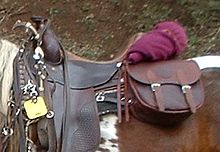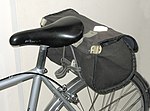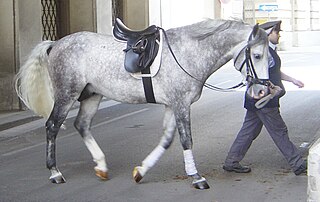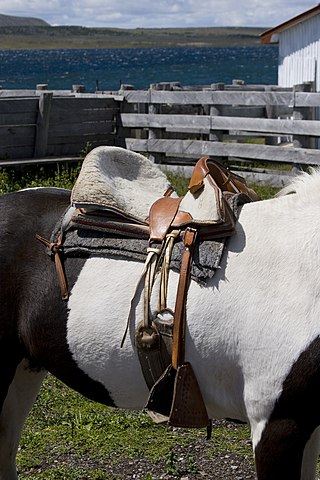

Saddlebags are bags that are attached to saddles.


Saddlebags are bags that are attached to saddles.

In horse riding, saddlebags sit in various positions, on the back, side, or front of the saddle. Most attach to the saddle by straps and ties. They can be made from various materials. Although leather was the traditional material, it is heavier and requires more maintenance than many modern versions. There are several types: Pommel bags (which sit in front of the saddle), traditional paired saddlebags (which lie on the hips of the horse, on either side of the cantle), and assorted smaller bags such as a cantle bag (a small tube-like bag that sits just behind the saddle), or a single small saddle bag that may be carried on the off-side (right hand side) of an English saddle.
Pannier-style bags are sometimes fitted over a pack saddle used for packing gear on a horse or other pack animal (often, a mule or donkey) rather than for carrying a rider. [1] In Turkish Anatolia, Iran and Baluchistan, saddlebags are traditionally woven in wool, with a front face decorated with Soumak and a plainer flatwoven back. Slits are left along the opening for a rope to close and secure the bag to the pack animal. [2] [3]

In bicycling, a saddlebag or seat bag is a bag attached under the saddle or seat. Smaller bags are typically used to hold a few items such as spare inner tubes, puncture repair kit, tools, rain gear, food, first-aid kit, etc. Seat bags are common on touring bicycles, racing bicycles, and cross country mountain bikes.
Bags range from tiny to large (over 25 liters). Smaller bags, known as seat bags, wedge packs, or seat packs fit completely under the saddle. Larger bags which project behind and sideways are usually called saddlebags; a well-known example is the Carradice Long Flap, for many years a staple of British cycle tourists especially on the weekends.
Recumbent bicycles have much larger seats than the saddle of a conventional bicycle, and special bags are available which attach to the seat; these are also called seat bags but are typically the size of small touring panniers.

On a motorcycle, modern panniers are normally hard-shell cases mounted behind the seat and on either-side of the rear wheel, attached to a framework (which bolts to the motorcycle frame) known as a carrier. Modern panniers are made to be quickly-detachable.
Historically, the origins were in military use for despatch riders, where soft, often canvas-type woven material bags were fitted to the motorcycle by rudimentary frames enabling the rider to carry documents securely. After hostilities ended, any left-over items including the motorcycles could be obtained from army-surplus depots, particularly after World War II during the 1950s when there was an increase in motorcycle use as a cheap form of transport.
Saddlebags also are available as modern motorcycle accessories (similar to western saddlebags described above) to place across the rear portion of the motorcycle seat, making them quickly detachable. They can then be carried over the arm or shoulder of the rider.
Made of leather or vinyl (leathercloth or imitation leather) with stiffening, they are known as Throwovers and come in different shapes and sizes to be used as travel luggage or a handy temporary container for items such as shopping.

A touring bicycle is a bicycle designed or modified to handle bicycle touring. To make the bikes sufficiently robust, comfortable and capable of carrying heavy loads, special features may include a long wheelbase, frame materials that favor flexibility over rigidity, heavy duty wheels, and multiple mounting points.

A pannier is a basket, bag, box, or similar container, carried in pairs either slung over the back of a beast of burden, or attached to the sides of a bicycle or motorcycle. The term derives from a Middle English borrowing of the Old French panier, meaning 'bread basket'.

English saddles are used to ride horses in English riding disciplines throughout the world. The discipline is not limited to England, the United Kingdom in general or other English-speaking countries. This style of saddle is used in all of the Olympic and International Federation for Equestrian Sports (FEI) equestrian disciplines, except for the newly approved FEI events of equestrian vaulting and reining. Most designs were specifically developed to allow the horse freedom of movement, whether jumping, running, or moving quickly across rugged, broken country with fences. Unlike the western saddle or Australian Stock Saddle, there is no horn or other design elements that stick out above the main tree of the saddle.

Western saddles are used for western riding and are the saddles used on working horses on cattle ranches throughout the United States, particularly in the west. They are the "cowboy" saddles familiar to movie viewers, rodeo fans, and those who have gone on trail rides at guest ranches. This saddle was designed to provide security and comfort to the rider when spending long hours on a horse, traveling over rugged terrain.

Sidesaddle riding is a form of equestrianism that uses a type of saddle which allows female riders to sit aside rather than astride an equine. Sitting aside dates back to antiquity and developed in European countries in the Middle Ages as a way for women in skirts to ride a horse in a modest fashion while also wearing fine clothing. It has retained a specialty niche even in the modern world.

A pack animal, also known as a sumpter animal or beast of burden, is an individual or type of working animal used by humans as means of transporting materials by attaching them so their weight bears on the animal's back, in contrast to draft animals which pull loads but do not carry them.

A handbag, commonly known as a purse or pocketbook in North American English, is a handled medium-to-large bag used to carry personal items.

A surcingle is a strap made of leather or leather-like synthetic materials such as nylon or neoprene, sometimes with elastic, that fastens around the horse's girth.

A messenger bag is a type of sack, usually made of cloth. It is worn over one shoulder with a strap that goes across the chest resting the bag on the lower back. While messenger bags are sometimes used by couriers, they are now also an urban fashion icon. Some types of messenger bags are called carryalls. A smaller version is often called a sling bag.

A girth, sometimes called a cinch, is a piece of equipment used to keep the saddle in place on a horse or other animal. It passes under the barrel of the equine, usually attached to the saddle on both sides by two or three leather straps called billets. Girths are used on Australian and English saddles, while western saddles and many pack saddles have a cinch, which is fastened to the saddle by a single wide leather strap on each side, called a latigo.

A saddle is a supportive structure for a rider of an animal, fastened to an animal's back by a girth. The most common type is equestrian. However, specialized saddles have been created for oxen, camels and other animals. It is not known precisely when riders first began to use some sort of padding or protection, but a blanket attached by some form of surcingle or girth was probably the first "saddle", followed later by more elaborate padded designs. The solid saddle tree was a later invention, and though early stirrup designs predated the invention of the solid tree, the paired stirrup, which attached to the tree, was the last element of the saddle to reach the basic form that is still used today. Today, modern saddles come in a wide variety of styles, each designed for a specific equestrianism discipline, and require careful fit to both the rider and the horse. Proper saddle care can extend the useful life of a saddle, often for decades. The saddle was a crucial step in the increased use of domesticated animals, during the Classical Era.

A bicycle saddle, often called a bicycle seat, is one of five contact points on an upright bicycle, the others being the two pedals and the two handles on the handlebars. The bicycle saddle has been known as such since the bicycle evolved from the draisine, a forerunner of the bicycle. It performs a similar role as a horse's saddle, not bearing all the weight of the rider as the other contact points also take some of the load.

A pack saddle is any device designed to be secured on the back of a horse, mule, or other working animal so it can carry heavy loads such as luggage, firewood, small cannons, or other things too heavy to be carried by humans.

The Australian stock saddle is a saddle in popular use all over the world for activities that require long hours in the saddle and a secure seat. The saddle is suitable for cattle work, starting young horses, everyday pleasure riding, trail riding, endurance riding, polocrosse and is also used in Australian campdrafting competitions and stockman challenges.
Motorcycle accessories are features and accessories selected by a motorcycle owner to enhance safety, performance, or comfort, and may include anything from mobile electronics to sidecars and trailers. An accessory may be added at the factory by the original equipment manufacturer or purchased and installed by the owner post-sale as aftermarket goods. The term Farkle is used within the motorcycle community, originally to denote useful add-ons, such as GPS or other upgraded components. Now also used at times in a humorous or mildly derogatory way to describe bling, such as anodized or chromed parts that add no functionality.

The Swiss Army Bicycle, the M0-5, and later the MO-93, was utilized by the Swiss Army from 1905 until the mid-1990s. In 2012 a new, lighter MO-12 or Fahrrad 12 was procured.

Soumak is a tapestry technique of weaving sturdy, decorative fabrics used for carpets, rugs, domestic bags and bedding, with soumak fabrics used for bedding known as soumak mafrash.

Kura (鞍), is the generic name for the Japanese saddle. The word "kura" is most commonly associated with the saddle used by the samurai class of feudal Japan. Over time the Japanese added elements of their own until the Japanese saddle became an identifiable style, also known as the samurai saddle.